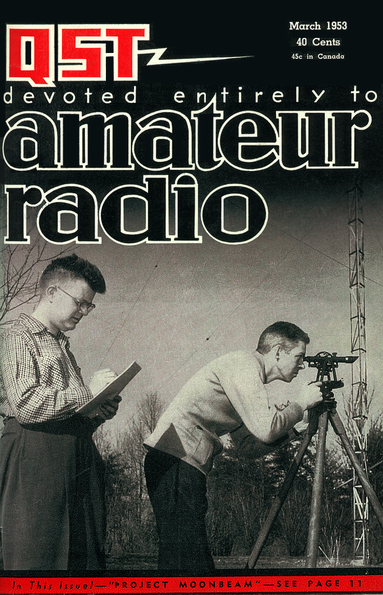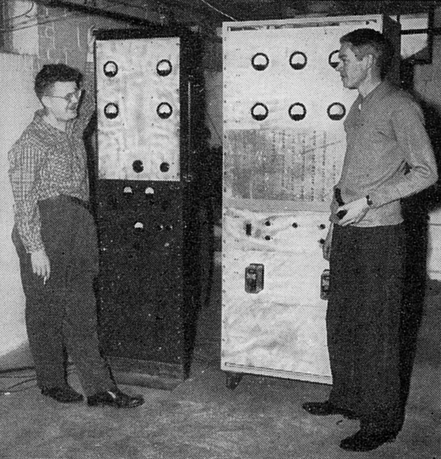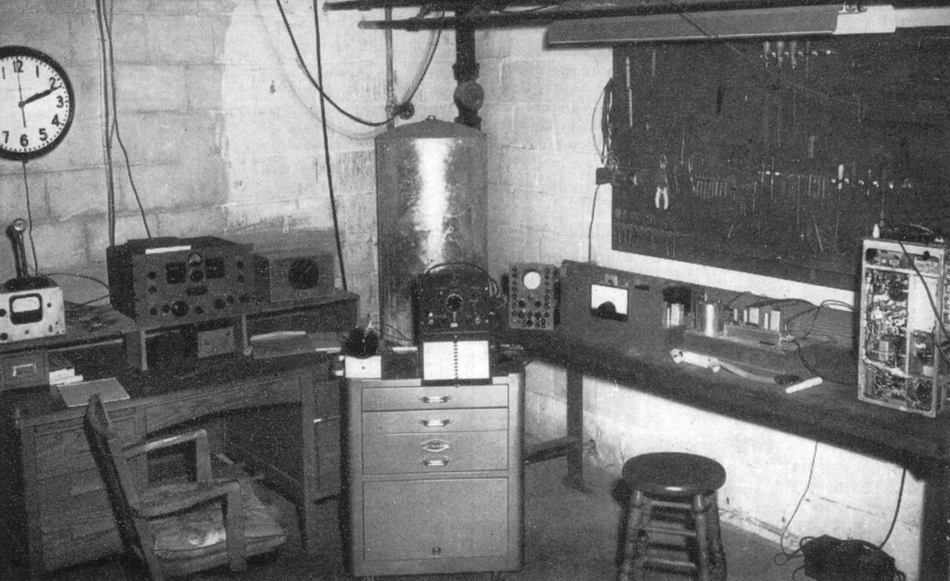|

Lunar DX on 144 Mc.!
[1953]
W4AO and W3GKP Bounce 2-Meter Signals
Off the Moon

|
OUR COVER:
Aiming an antenna at the moon is an
exacting proposition. Our cover shows W4AO, left, and W3GKP
checking the alignment of the 20 wavelength stacked rhombics
used for Project Moonbeam. |
|
Listening
to the wire recording from which
the above graph was made, it doesn’t sound like
much; a one-second beep, an interval of receiver noise, then a
wavering trailing bee-e-e-e-p barely discernible in the midst of the
slightly musical rushing sound that is characteristic of high-selectivity
reception. You wouldn’t be impressed if you
happened to hear it casually, but to Ross Bateman, W4AO, and Bill Smith,
W3GKP, it was music of the sweetest sort; evidence that more years of
thinking, figuring, building, re building and testing were not in vain. An
amateur signal had been sent to the moon and back, at last!
Bouncing signals off the moon is not new, of
course. It was done on 110 Mc. by the Signal Corps back in 19461
and something approximating intelligence was sent from Cedar Rapids, Iowa,
to Washington, D. C., on 400 Mc. more recently, using the moon as a
reflector. These were high-power projects, however, and their slim margin
of success indicated that lunar DX for amateurs was a long-chance
proposition. It was an end that just might be achieved, but only after the
most painstaking effort, if at all.
The best available information indicated that
it would take the level amateur power limit, pushed to the last watt. An
antenna gain of at least 20 dB was required, and
a degree of receiver performance to tax the ingenuity of the best
engineers in the business was called for. Obviously, a 144
Mc. WAS, lunar style, was a long way off, but it was a challenge
that a few enter prising and infinitely patient hams were bound to accept.
One such ham was Bill Smith, W3GKP, then of
Silver Spring, Maryland. Smitty knew what he was about, and he went at the
job with no illusions about aiming his beam at the rising moon
some night
and then sitting back to listen to the W6s. He knew the requirements, in a
general way, and he felt sure that the trick could be turned, eventually.
The first step was to find a co-worker, so that the burden of equipment
development and construction could be shared. A ham with a kilowatt rig
and a big beam for 144 Mc. would be a fine start. Several prospects were
lined up, and early in 1950 a few transmitting tests were made, while
W3GKP worked on his receiving gear, but none of the prospects had
sufficiently good equipment to make reception possible at that stage of
the game.
Other amateurs, among them
W4AO, Falls Church, Va., had been working along similar lines. Learning of
W3GKP’s interest, Ross joined forces with Smitty, and Project Moonbeam was
on its way in earnest. Ross brought to the operation the technical
know-how and the enthusiasm and perseverance Smitty had been looking for,
and he had a 2-meter rig capable of a full and efficient kilowatt, a
32-element array, a low-noise receiver and a quiet suburban location.
After many evenings of discussion, planning and construction, the stage
was set for a series of tests with a set-up that appeared to have some
chance of succeeding.
The rig at W4AO was
maintained on frequency precisely, and keyed in one-second pulses.

|
Ross Bateman, W4AO, left, and Bill Smith,
W3GKP, smile happily over the success of Project Moonbeam, after
three years of trying. The high-power stages of the 1 kW. 2-meter
transmitter are in the left-hand rack, as are crystal-controlled
converters for 144 and 50 Mc. The large cabinet houses power
supplies, modulator and control circuits. |
|
The required separation in
frequency between the transmitter and receiver frequencies (to take care
of Doppler effects resulting from movements of the earth and moon) had
been calculated, and the receiver frequency set with elaborate stability
precautions. A wire recorder was connected to the receiver output, to
catch as permanent evidence any sign of a returned signal. The system was
put in operation whenever the moon was in the right place, and no minor
considerations like eating or sleeping were allowed to interfere.
At long last, at 5:03 A.M.
on July 15, 1950, came something that sounded like an echo. It was faint
and indefinite, but it started at the right time and it sounded like the
real thing. What was more important, it was caught on the wire recorder.
It was just one tiny beep after a long series of transmitter pulses, but
it was enough to keep enthusiasm going.
Workers of lesser stature
might have called in the press and announced their results to the world,
but Ross and Smitty wanted something more solid than a single faint and
somewhat dubious return on which to rest their case. Copies of the
recording were mailed out to a few interested parties who could be trusted
to say nothing until given the word, and Moonbeam went on and on. (A wire
copy of that first success has rested in the desk of QST’s V.H.F. Editor
for nearly three years.)
Test after test piled
failure on failure, but still the beeps were sent. An infinitesimal
improvement in receiver noise figure, another decibel of antenna gain, a
correction of a degree of antenna aiming error, an improved method of
“reading” signals inaudible in the noise; any or all of these might tip
the balance. Methods that were tried and found wanting will not be
recounted here, but they were many.
Moving to a new home
location necessitated the dismantling of the receiving set-up at W3GKP, so
Moonbeam moved its entire facilities to the basement at W4AO. In November,
1952, a huge stacked rhombic was erected and tested, and it showed a
gratifying improvement over the 32-element array. A system had been
devised to tie in transmitter and receiver frequencies together
accurately. A new receiver front end brought the noise figure down under 4
dB.
Tests on November 30th and
December 3rd brought no results, so a slight modification was made in the
rhombic design, to radiate maximum signal at 2 degrees above the horizon,
in readiness for the next round December 27th. There were some very faint
returns this time, but nothing tangible on the 30th and 31st.
 Part of the equipment used in Project Moonbeam, as it operates in the
basement at W4AO, Falls Church, Va. At the control position is the
Super-Pro receiver, flanked by microphone preamplifier and beam direction
indicator. The rolling table, center, carries frequency-checking gear. On
the workbench at the right are the frequency control units and exciter.
The high-power stages of the transmitter are out of sight at the right, in
racks that also house the crystal-controlled converters for the v.h.f.
bands.
Part of the equipment used in Project Moonbeam, as it operates in the
basement at W4AO, Falls Church, Va. At the control position is the
Super-Pro receiver, flanked by microphone preamplifier and beam direction
indicator. The rolling table, center, carries frequency-checking gear. On
the workbench at the right are the frequency control units and exciter.
The high-power stages of the transmitter are out of sight at the right, in
racks that also house the crystal-controlled converters for the v.h.f.
bands.
Meanwhile, the staff of
Moonbeam had been augmented by the addition of Ted Tuckerman, W3LZD, of
Dunmore, Penna., who erected a 30-wavelength rhombic array in time for
tests in late January. The receiver bandwidth at W4AO was shaved another
notch for this try, too.
Ted arranged to listen for
the ground-wave signal with his normal 2-meter array aimed at W4AO, and
then switch to the moon rhombic to try for the echo. His low-noise
crystal-controlled converter and communications receiver were equipped
with a super-selective 50 kc. if, system built by W3LCK. On January 23rd,
this combination produced its first positive results, and a series of weak
echoes was received at W3LZD, at a time when nothing was detected by the
set-up at W4AO.
Tests the following
afternoon produced nothing, but beginning at 1533 EST on the 27th, a whole
series of echoes was recorded at W4AO, two cycles of which are reproduced
at the start of this article. Success, at last, and in sufficient quantity
and quality to provide irrefutable evidence!
The equipment used in this
and earlier stages of Moonbeam will be described by W4AO and W3GKP in a
subsequent issue of QST. Now the question is, “Where do we go from here?”
As Smitty puts it, “This is the end of Phase A - we’ve got an echo. Phase
B will be to transmit intelligence to another station. Phase C will be to
work somebody, two-way. Phase D will be to break the 2-meter record.
Phases E, F - well, can go on almost indefinitely. After three years we’re
just getting started!”
-E. P. T.
1 Kaufman, “A DX Record: To
the Moon and Back,” QST, May, 1946.
2 Sulzer, Montgomery, and
Gerks, “An UHF. Moon Relay,” Proc. IRE, March,
1951, p. 361.
 CONDUCTED BY E. P. TILTON,
W1HDQ
CONDUCTED BY E. P. TILTON,
W1HDQ
The January success of
Project Moonbeam, reported last month, was no one-shot proposition. With a
fixed antenna, the opportunities for tests don’t come too often, but W4AO,
and W3GKP were ready for another try on Feb. 20th, the next time the moon
was in the right place. With W3GKP at the controls, a series of test
transmissions beginning at 10:15 A.M. was made from W4AO. Optimum time for
echoes was expected to be between 10:40 and 10:50, and it turned out very
nearly that way.
Many moon echoes were
received at Falls Church between 10:34 and 10:53. The peak strength of the
returning signals was slightly lower than in January, and fading was more
rapid and violent. Up in Dunmore, Pa., W3LZD was having the best results
to date. Ted’s reception of the moon-reflected W4AO signal ran from 10:37
to 10:43, reappearing briefly at 10:49.
The release of information
on the first successful amateur moon-reflection efforts, by means of W1AW
Bulletins, nationwide ARRL press re leases, and the story in March Q has
caused widespread interest in further attempts at lunar DX. Many hams, it
seems, have been working in this direction; quite a few of them with a
good understanding of the difficulties involved. We offer the services of
this department as a means of correlating effort. If you are working on a
moon project, send us the information on your equipment and schedules. If
there is sufficient response, we will arrange to supply interested workers
with up-to-date information by mimeo graph.
For those who would like to
know more about what it takes to bounce a 2-meter signal off the moon,
W4AO and W3GKP are in the process of compiling a comprehensive report on
Project Moonbeam. We hope to have it for you in an early issue of QST.
QST March/April 1953
for OK2KKW web rewrited and edited
Matej,
OK1TEH |